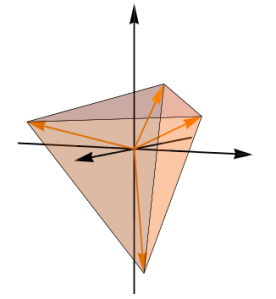I contracted the SIC-POVM sickness a month ago after reading a paper by Gelo Tabia and Marcus Appleby who explore the qutrit case in great detail. I got over it in a week or so just to contract it again today when a paper by Gilad Gour came out. It has a very promising title that ends with “…symmetric informationally complete measurements exist in all dimensions”. Unfortunately, it begins with “General…”. Let’s see what the paper is about. Update: Chris Ferrie has pointed out to me that a similar result has already been obtained by Marcus Appleby (see Sect. 4 of this paper).
Intuition
The geometric intuition of this result can be summarized as follows:
- Choose an arbitrary orthonormal basis for the linear space of all
Hermitian matrices.
- Construct a simplex out of these basis vectors in some specific way (see below).
- Shrink it sufficiently small so that it fits inside the positive-semidefinite cone.
The last step always works, because the convex body formed by all density matrices contains a ball around the maximally mixed state. The required amount of shrinking is determined by parameter in Theorem 1 (it is also related via Eq. (7) to parameter
that measures the “purity” of the resulting SIC-POVM).
Details and example
The second step can be described more precisely as follows. Let be an arbitrary orthonormal basis of
(think of it as the space of all
traceless Hermitian matrices). Then a regular simplex with vertices
can be obtained as follows:
where and
is the sum of all
(these expressions correspond to Eq. (5) in the paper). For example, if
and
is the i-th standard basis vector, then vectors
are the rows of the following matrix:
They look like this in 3D (the orange arrows):

Note that
hence vectors indeed form a simplex in
. In fact, this construction works in any dimension — there is nothing special about it being of the form
.
Open questions
The hard question (which is still open) is how to choose the basis so that you need to shrink the simplex as little as possible. In other words, you want the matrices associated to
to have rank one. All we know about this case is that the matrices
associated to the basis vectors
must have certain eigenvalues given by Eq. (11) in the paper. How close do we get to this if
are generalized Pauli matrices or Haar random?
It would be interesting to know if anything extra can be said about the matrices if the SIC-POVM obeys Weyl-Heisenberg symmetry (in prime dimensions this is without loss of generality due to Huangjun Zhu).